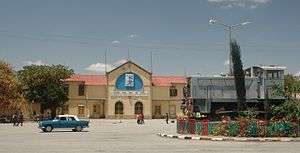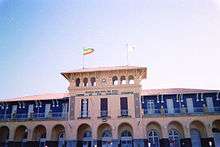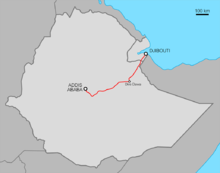Ethio-Djibouti Railways
| Ethio-Djibouti Railways | |
|---|---|
|
Map of the Ethio-Djibouti Railway line | |
| Overview | |
| Other name(s) | Franco-Ethiopian Railway |
| System | Heavy rail |
| Status | Abandoned |
| Termini |
Addis Ababa Djibouti |
| Operation | |
| Opened | 1917 |
| Technical | |
| Line length | 784 km (487 mi) |
| Track gauge | 1,000 mm (3 ft 3 3⁄8 in) metre gauge |
Ethio-Djibouti Railways | |||||||||||||||||||||||||||||||||||||||||||||||||||||||||||||||||||||||||||||||||||||||||||||||||||||||||||||||||||||||||||||||||||||||||||||||||||||||||||||||||||||||||||||||||||||||||||||||||||||||||||||||||||||||||||||||||||||||||||||||||||||||||||||||||||||||||||||||||||||||||||||||||||||||||||||||||||||||||||||||||||||||||||||||||||||||||||||||||||||||||||||||||||||||||||||||
|---|---|---|---|---|---|---|---|---|---|---|---|---|---|---|---|---|---|---|---|---|---|---|---|---|---|---|---|---|---|---|---|---|---|---|---|---|---|---|---|---|---|---|---|---|---|---|---|---|---|---|---|---|---|---|---|---|---|---|---|---|---|---|---|---|---|---|---|---|---|---|---|---|---|---|---|---|---|---|---|---|---|---|---|---|---|---|---|---|---|---|---|---|---|---|---|---|---|---|---|---|---|---|---|---|---|---|---|---|---|---|---|---|---|---|---|---|---|---|---|---|---|---|---|---|---|---|---|---|---|---|---|---|---|---|---|---|---|---|---|---|---|---|---|---|---|---|---|---|---|---|---|---|---|---|---|---|---|---|---|---|---|---|---|---|---|---|---|---|---|---|---|---|---|---|---|---|---|---|---|---|---|---|---|---|---|---|---|---|---|---|---|---|---|---|---|---|---|---|---|---|---|---|---|---|---|---|---|---|---|---|---|---|---|---|---|---|---|---|---|---|---|---|---|---|---|---|---|---|---|---|---|---|---|---|---|---|---|---|---|---|---|---|---|---|---|---|---|---|---|---|---|---|---|---|---|---|---|---|---|---|---|---|---|---|---|---|---|---|---|---|---|---|---|---|---|---|---|---|---|---|---|---|---|---|---|---|---|---|---|---|---|---|---|---|---|---|---|---|---|---|---|---|---|---|---|---|---|---|---|---|---|---|---|---|---|---|---|---|---|---|---|---|---|---|---|---|---|---|---|---|---|---|---|---|---|---|---|---|---|---|---|---|---|---|---|---|---|---|---|---|---|---|---|---|---|---|---|---|---|---|---|---|---|---|---|---|---|---|---|---|---|---|---|---|---|---|---|---|---|---|---|---|---|
Legend | |||||||||||||||||||||||||||||||||||||||||||||||||||||||||||||||||||||||||||||||||||||||||||||||||||||||||||||||||||||||||||||||||||||||||||||||||||||||||||||||||||||||||||||||||||||||||||||||||||||||||||||||||||||||||||||||||||||||||||||||||||||||||||||||||||||||||||||||||||||||||||||||||||||||||||||||||||||||||||||||||||||||||||||||||||||||||||||||||||||||||||||||||||||||||||||||
| |||||||||||||||||||||||||||||||||||||||||||||||||||||||||||||||||||||||||||||||||||||||||||||||||||||||||||||||||||||||||||||||||||||||||||||||||||||||||||||||||||||||||||||||||||||||||||||||||||||||||||||||||||||||||||||||||||||||||||||||||||||||||||||||||||||||||||||||||||||||||||||||||||||||||||||||||||||||||||||||||||||||||||||||||||||||||||||||||||||||||||||||||||||||||||||||
Ethio-Djibouti Railways (French: Compagnie du Chemin de Fer Djibouto-Éthiopien[1]), also known as the Ethio-Djibouti Railway Enterprise, is a railway company based in the Horn of Africa. It was established in 1981 as the successor to the Franco-Ethiopian Railway, and it is jointly owned by the governments of Ethiopia and Djibouti.[2]
The railway links Addis Ababa, the capital of landlocked Ethiopia, to the Port of Djibouti in Djibouti City. Maintenance shops along the line are located in Dire Dawa, which grew up as the railway depot for nearby Harar.
The railroad is currently abandoned between Addis Ababa and Dire Dawa. Through trains have not run since 2008.[3] Service is available between Dire Dawa and Djibouti.[4] The parallel Addis Ababa–Djibouti Railway, a electrified standard gauge railway, began freight operations in October 2016.[5] It was built and is operated by Chinese state-owned companies.[6]
Overview
The single track 781 km railway has a 1,000 mm (3 ft 3 3⁄8 in) gauge, most of it on Ethiopian territory, and about 100 km in Djibouti.[7] There are 187 bridges along the route, but only one tunnel at Gol du Harr, northeast of Dire Dawa.[8]
The company is headquartered in Addis Ababa; the ministers of the Djiboutian Ministry of Equipment and Transport and the Ethiopian Ministry of Transportation and Communications are the president and vice-president of the company.
History
The Imperial Railway Company of Ethiopia (French: Compagnie Impériale des Chemins de fer d'Éthiopie[9] or Compagnie Impériale Éthiopienne[1]) was a firm founded in 1894 to build and operate a railway across eastern Ethiopia from the port of Djibouti to the capital of Addis Ababa. It was founded by Alfred Ilg and Léon Chefneux and headquartered in Paris, France.[9] The firm failed in 1906 when political discord halted construction, and it failed to obtain any new capital. The portion it had completed ran from Djibouti to just short of Harar,[10] the principal entrepôt for existing commerce in southern Ethiopia.[11] During the era of Emperor Menelik II the Somali clans Issa and Gadabursi were among the railway workers when the Addis Ababa-Djibouti railway was under construction and greatly benefited from it.[12] Also Its terminus evolved into the city of Dire Dawa, today a larger city than Harar itself.
Origins

Discussion of an Ethiopian railway was initiated by Alfred Ilg, an advisor to Emperor Menelek II. He had attempted to interest the previous emperor and other Ethiopian political figures in the construction of a railway to replace the six-week mule trek between the capital and the French port city, but had no success. When Menelek acceded to the throne in 1889, negotiations began anew and a decree was granted on February 11, 1893, to study the construction of rail line. Ilg, a Swiss citizen, and a number of French associates put together a firm and received a royal charter on March 9, 1894, enabling them to start work. Menelek resisted personally putting any funds into the venture, but did grant a 99-year lease to Ilg and his associates in return for a number of shares in the firm and half of all profits in excess of 3,000,000 francs. Furthermore, the firm was obliged to construct a telegraph line along the route.
It took until 1897 before the necessary permission from French authorities was received, by which time significant opposition in Ethiopia had materialized. The emperor himself was irate at the involvement of the French government, which had offered to fund the line,[9] and there were popular demonstrations against it. There was also opposition from the British legation in Addis Ababa, which feared a reduction in traffic to the port of Zeila in British Somaliland. (These fears proved well-founded: even half-finished, without links to either Harar or Addis Ababa, the railroad quickly eclipsed the port's former caravan-based trade.[11])
The firm also had difficulty selling its shares in Europe. Robert Le Roux campaigned for the line at municipal chambers of commerce around France,[13] but investor interest was restrained and Menelek was opposed to offers of direct involvement by the French government.[9] All in all, the initial stock offering only earned 8,738,000 francs of the 14 million projected, and an additional offering of 25.5 million francs of bonds yielded only 11,665,000 francs. This was far too little to complete the line. Despite the shortfall, construction began in October 1897 from Djibouti, a hitherto minor port that expanded primarily to serve the railway.
A crew of Arab and Somali workers, overseen by Europeans, began to press inland with the line and its associated telegraph. Ethiopians were hired largely as security forces, to prevent the theft of materials on the line. This was also an important source of corruption for the primarily French administration, which fabricated incidents of sabotage and requested funds to buy off local chiefs that it claimed were responsible for it. Furthermore, the line was forced to avoid interfering with local communities and water sources, pushing it out into the desert. This meant that the railway company had to build aqueducts, an additional unplanned expense, to serve the line.
Even before reaching the Ethiopian border, it was clear the firm had serious financial problems. A group of British investors calling themselves the New Africa Company effectively took control of the firm over several years. They provided a new source of capital, and by 1901 had joined with the French investors to form the International Ethiopian Railway Trust and Construction Company - a holding firm which essentially controlled the railway and supplied it with further capital. The first commercial service began in July 1901, from Djibouti to Dire Dawa.
Completion

The mixture of French and British interests proved volatile, as each group of investors stood increasingly for both national and commercial interests. Both governments became interested in monopolizing Ethiopian trade and conspired to force the other into a minor position. The demands and threats of the two governments led Emperor Menelek in 1902 to forbid the expansion of the railway line to Harar. French negotiations to resume work were blocked by Menelek's growing suspicion of French motives, and the line could not earn enough to pay back the company's debts with such a limited service. The signature of the Entente Cordiale in 1904 reopened the possibility of continued joint Anglo-French investment and development, but there was enough resistance to such proposals on both sides that no progress was made. The firm went formally bankrupt in 1906.
Following the 1906 Tripartite Treaty between Italy, France, and Britain and the 1908 Klobukowski Treaty between France and Ethiopia, Menelek consented to further expansion of the railway, granting the new concession to his personal physician, a black Guadaloupean named Dr. Vitalien, on 30 January 1908.[14] The assets of the former company were then transferred to a new firm, the Franco-Ethiopian Railway (Compagnie du Chemin de Fer Franco-Éthiopien[1]), which received a new concession to finish the line to Addis Ababa. After a year of wrangling with the previous financiers and their governments, construction began anew. By 1915 the line reached Akaki, only 23 kilometers from the capital, and two years later came all the way to Addis Ababa itself.
Post-World War II
Workers for the Railway were pioneers in the Ethiopian labor movement. They organized one of the first labor unions in Ethiopia in 1947, the Railroad Workers Syndicate of Dire Dawa, for mutual welfare purposes.[15] Although its leadership co-operated with the Government, an attempted strike in 1949 was brutally suppressed by government troops; at the time, all strikes were seen by government officials as a form of insurrection.[16]
The railway company carried out surveys for extending its line 310 kilometers south from Adama to Dilla between 1960 and 1963. The government formed a Nazareth-Dilla Railway Development Corporation to support this new branch. Although the French government offered a loan to fund this new branch in 1965, and Yugoslav experts had studied and thought the project would be worthwhile, this project was never carried out.[17]
Ethiopia's share in the railway was seized by the Italian government in the Second Italo-Abyssinian War, but was regained by Ethiopia after the World War II. Following the independence of Djibouti in 1977, the French share in the railway was transferred to the new nation. Around 1982, the railway was subsequently reorganized as the Ethio-Djibouti Railways (Compagnie du Chemin de Fer Djibouto-Éthiopien[1]).
Decline
After World War II, the railway began a long period of decline. Traffic on the railway dropped in half from 1953 to 1957, as road transport began to compete for cargo.[18] The Ogaden War of 1977-1978 dealt a further blow to the railway, as Somali troops invaded Ethiopia and captured the railway as far as Dire Dawa.[19] Portions of the railway were blown up in the war, and railway operations were again cut in half.[20] After the war ended, the railway continued to decline from a lack of maintenance and attacks from rebels such as the Ogaden Liberation Front.[21]
The governments of Ethiopia and Djibouti pursued foreign aid to rehabilitate the railway. The European Commission prepared a grant of EUR 40 million in 2003 and raised it to EUR 50 million in 2006. On November 29, 2006, an agreement was signed with the Italian consortium Consta, and work began in 2007 on sections of the line that deteriorated following the Ogaden War.[22] In 2006, the South African firm Comazar was chosen to receive a 25-year concession.[23] However, this plan was not executed, and in early 2008, it was announced that the railway was in negotiations with the Kuwaiti company Fouad Alghanim and Sons Group.[24]
The EU-funded project stagnated, and only 5 km of tracks had been rehabilitated by 2009.[25] The railway is currently in a partially-abandoned state.[26] There has been no passenger service between Dire Dawa and Addis Ababa since 2008.[4] The service from Djibouti to Dire Dawa ceased in August 2010 but restarted in August 2013.[4][27]
Replacement
After the failure of the rehabilitation project, the two governments decided on a different approach to railway modernization. $3 billion of loans were secured from the Exim Bank of China to build an electrified standard gauge railway, parallel to the old line.[28][29] The new Addis Ababa–Djibouti Railway was built by Chinese state-owned companies between 2011 and 2016.
Addis Ababa railway station

The Addis Ababa railway terminal, La Gare, is a century-old historical building. In 2008 a street project threatened to lead to its isolation or demolition.[30]
See also
References
Notes
- 1 2 3 4 Crozet, Jean-Pierre. Françoise Faulkner-Trine, trans. The Franco-Ethiopian and Djibouto-Ethiopian Railway and "History". 2013. Accessed 12 Feb 2014.
- ↑ Belda, Pascal (2006). Ebizguide Ethiopia. MTH Multimedia S.L. p. 180. ISBN 9788460796671.
Soon after the independence of Djibouti, the government of Ethiopia and Djibouti signed a new treaty on March 1981, for 50 years on equal parity ownership under "chemin de Fer Djibouto-Ethiopien" name.
- ↑ Vaughan, Jenny (March 10, 2013). "China's Latest Ethiopian Railway Project Shows Their Growing Global Influence". Agence France Presse.
While the economic benefits of the train -- which will be used for both freight and passenger transport, replacing slow and costly truck transport -- is widely recognised, some lament the seemingly inevitable death of the historic French-built diesel-powered train, which went out of service in 2008 after years of neglect.
- 1 2 3 April 27, 2015. "Train travel in Ethiopia & Djibouti". The Man in Seat 61. Archived from the original on April 27, 2015.
Most of the guide books have the info’ on the train completely wrong, most of them still saying the train departs Addis Ababa but this has not happened for over two years. They also say the train does not operate at night because of the chances of attacks, but this is also wrong as the train I caught on Sunday 20-12-2009 departed at 10.30am (over a day late) and arrived Djibouti at 05.30am the next. I spent over 18 hours in the cab!!!!
- ↑ "Ethiopia-Djibouti electric railway line opens". BBC News. 5 October 2016. Accessed 3 November 2016.
- ↑ "Addis Ababa-Djibouti railway project is 98% complete". Railway Pro. August 4, 2016.
- ↑ "The World Factbook". CIA.
- ↑ Belda, Pascal (2006). Ebizguide Ethiopia. MTH Multimedia S.L. pp. 180–181. ISBN 9788460796671.
CDE has over 187 steel bridges with spans varying from 4 to 141 meters. Gol du Harr, located at North-East of Dire Dawa, at Km 181, is the only tunnel along the rail track.
- 1 2 3 4 "Ilg, Alfred" in the Encyclopædia Æthiopica, Vol. 3, pp. 120 ff. Accessed 17 Mar 2014.
- ↑ "Abyssinia" in the Encyclopædia Britannica 11th ed.
- 1 2 "Zaila" in the Encyclopædia Britannica 11th ed. 1911.
- ↑ Negatu, Workneh; Research, Addis Ababa University Institute of Development; Center, University of Wisconsin--Madison Land Tenure; Foundation, Ford (2004-01-01). Proceedings of the Workshop on Some Aspects of Rural Land Tenure in Ethiopia: Access, Use, and Transfer. IDR/AAU. p. 43.
- ↑ "Le Roux, Robert Henri" in the Encyclopædia Æthiopica, Vol. 3, p. 551. Accessed 17 Mar 2014.
- ↑ "Klobukowski Treaty" in the Encyclopædia Æthiopica, Vol. 3. Otto Harrassowitz, 2007. Accessed 17 March 2013.
- ↑ "Local History in Ethiopia" (pdf) The Nordic Africa Institute website (accessed 1 March 2008)
- ↑ Edmund J. Keller, Revolutionary Ethiopia (Bloomington: Indiana University Press, 1988), p. 147
- ↑ "Dil Amba - Djibiet" (pdf). Local History in Ethiopia. The Nordic Africa Institute. 2005. Retrieved 2011-09-20.. The route of this proposed extension is shown on the map accompanying the article by Nathaniel T. Kenney, "Ethiopian Adventure", National Geographic Magazine, 127 (1965).
- ↑ Bergqvist, Rickard (2016). Dry Ports – A Global Perspective. Routledge. p. 93. ISBN 9781317147671.
- ↑ Cooper, Tom (2014). Wings over Ogaden: The Ethiopian-Somali war, 1978-1979. Helion. p. 56. ISBN 9781909982383.
- ↑ Middle East Economic Digest. 22: 11. 1978.
The railway line was cut frequently during the Ogaden war, but has been operating at 50 per cent capacity since July.
Missing or empty|title=(help) - ↑ "Addis Ababa–Djibouti Railway". Historical Dictionary of Ethiopia. Scarecrow Press. p. 23. ISBN 9780810874572.
- ↑ "Ethio-Djibouti Railway rehabilitation accord signed" Walta Information Center
- ↑ South African firm wins bid to administer Ethio-Djibouti railway Hiiran Online
- ↑ "No concession at Ethio-Djibouti Railway" Railway Gazette International September 2007
- ↑ Foch, Arthur (March 2011). "The paradox of the Djibouti-Ethiopia railway concession failure" (PDF). Private Sector & Development (9): 18.
For example, in 2009 only five kilometres of track had been rehabilitated. ... The two States gradually abandoned the CDE, which by 2011 had ceased all activities.
- ↑ Vaughan, Jenny (March 10, 2013). "China's Latest Ethiopian Railway Project Shows Their Growing Global Influence". Agence France Presse.
The train station -- known locally as "la gare" -- and the workshops still stand, unused for years. Employees still arrive at work diligently just after dawn every day, only to sit among the abandoned train cars and imported French machinery, seemingly frozen in time. They still receive a monthly stipend from the company, which is now run by the Ethiopian government. They hold out hope that the diesel train will be revived one day, but the European Commission-funded project to rehabilitate the old railway at a cost of $55 million has stalled due to a contractual dispute.
- ↑ Djibouti: Dire Dawa - Djibouti Railways Resumes Service, AllAfrica.com, Sep 6th, 2013
- ↑ Yewondwossen, Muluken (27 May 2013). "Ethiopia, Djibouti secure $3 bln loan for railway project". Capital Ethiopia.
The Ethiopian Railway Corporation (ERC) and the Djibouti government have secured nearly three billion dollars loan from the Chinese Export Import (EXIM) Bank for the construction of the railway project that stretches from Addis Ababa to Djibouti.
- ↑ Vaughan, Jenny (March 10, 2013). "China's Latest Ethiopian Railway Project Shows Their Growing Global Influence". Agence France Presse.
Two Chinese companies are contracted to build the $2.8 billion (2.15 billion euro) line connecting Addis Ababa to the Djiboutian border by 2016, and Turkish and Brazilian companies are slated to construct other segments of the nation-wide rail network.
- ↑ "Historic Addis Ababa railway station under threat" addis-ababa.wantedinafrica.com May 28, 2008 news regarding La Gare, accessed November 11, 2013.
Further reading
- Fontaine, Hugues: Un Train en Afrique. African Train. Centre Français des Études Éthiopiennes / Shama Books. Édition bilingue français / anglais. Traduction : Yves-Marie Stranger. Postface : Jean-Christophe Belliard. Avec des photographies de Matthieu Germain Lambert et Pierre Javelot. Addis Abeba, 2012, ISBN 978-99944-867-1-7. English and French.
- Killion, Tom C. "Railroad Workers and the Ethiopian Imperial State: The Politics of Workers' Organization on the Franco-Ethiopian Railroad, 1919-1959", The International Journal of African Historical Studies, 25 (1992), pp. 583–605.
- Robinson, Neil (2009). World Rail Atlas and Historical Summary. Volume 7: North, East and Central Africa. Barnsley, UK: World Rail Atlas Ltd. ISBN 978-954-92184-3-5.
External links
 Media related to Rail transport in Ethiopia at Wikimedia Commons
Media related to Rail transport in Ethiopia at Wikimedia Commons Media related to Rail transport in Djibouti at Wikimedia Commons
Media related to Rail transport in Djibouti at Wikimedia Commons- French website covering the history
- The Franco-Ethiopian Railway and Its History
- The Franco-Ethiopan Railway, 1936
- French website about the Djibouti-Addis Ababa train, from yesterday to today
